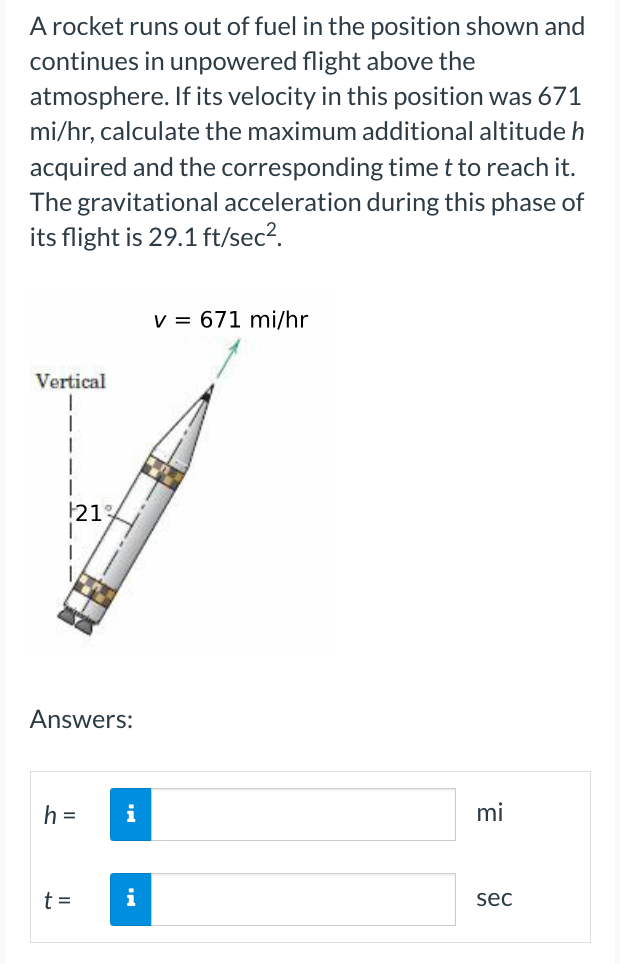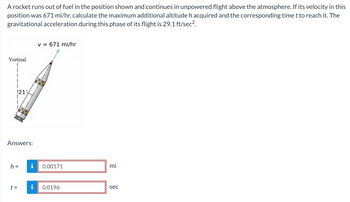A rocket runs out of fuel in the position shown and continues in unpowered flight above the atmosphere. If its velocity in this position was 671 mi/hr, calculate the maximum additional altitude h acquired and the corresponding time t to reach it. The gravitational acceleration during this phase of its flight is 29.1 ft/sec². Vertical I | 1 21% Answers: h = i v=671 mi/hr mi
A rocket runs out of fuel in the position shown and continues in unpowered flight above the atmosphere. If its velocity in this position was 671 mi/hr, calculate the maximum additional altitude h acquired and the corresponding time t to reach it. The gravitational acceleration during this phase of its flight is 29.1 ft/sec². Vertical I | 1 21% Answers: h = i v=671 mi/hr mi
International Edition---engineering Mechanics: Statics, 4th Edition
4th Edition
ISBN:9781305501607
Author:Andrew Pytel And Jaan Kiusalaas
Publisher:Andrew Pytel And Jaan Kiusalaas
Chapter1: Introduction To Statics
Section: Chapter Questions
Problem 1.19P: Plot the earths gravitational acceleration g(m/s2) against the height h (km) above the surface of...
Related questions
Question

Transcribed Image Text:A rocket runs out of fuel in the position shown and
continues in unpowered flight above the
atmosphere. If its velocity in this position was 671
mi/hr, calculate the maximum additional altitude h
acquired and the corresponding time t to reach it.
The gravitational acceleration during this phase of
its flight is 29.1 ft/sec².
Vertical
1
|
1
21%
Answers:
h=
t=
i
i
v = 671 mi/hr
mi
sec
Expert Solution
This question has been solved!
Explore an expertly crafted, step-by-step solution for a thorough understanding of key concepts.
This is a popular solution!
Trending now
This is a popular solution!
Step by step
Solved in 3 steps with 2 images

Follow-up Questions
Read through expert solutions to related follow-up questions below.
Follow-up Question

Transcribed Image Text:A rocket runs out of fuel in the position shown and continues in unpowered flight above the atmosphere. If its velocity in this
position was 671 mi/hr, calculate the maximum additional altitude h acquired and the corresponding time t to reach it. The
gravitational acceleration during this phase of its flight is 29.1 ft/sec².
Vertical
|
1
1
Answers:
h =
21%
t =
i
i
v=671 mi/hr
0.00171
0.0196
mi
sec
Solution
Knowledge Booster
Learn more about
Need a deep-dive on the concept behind this application? Look no further. Learn more about this topic, mechanical-engineering and related others by exploring similar questions and additional content below.Recommended textbooks for you

International Edition---engineering Mechanics: St…
Mechanical Engineering
ISBN:
9781305501607
Author:
Andrew Pytel And Jaan Kiusalaas
Publisher:
CENGAGE L

International Edition---engineering Mechanics: St…
Mechanical Engineering
ISBN:
9781305501607
Author:
Andrew Pytel And Jaan Kiusalaas
Publisher:
CENGAGE L